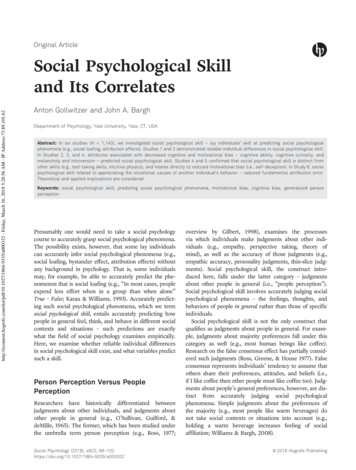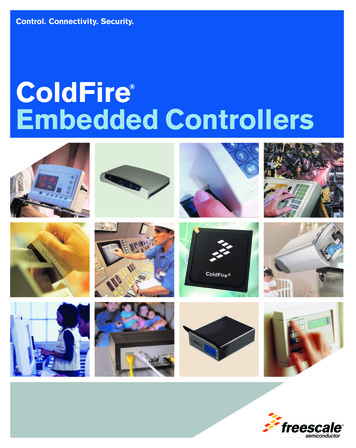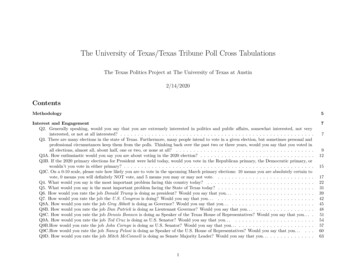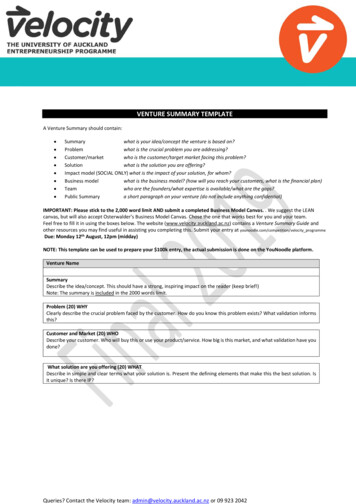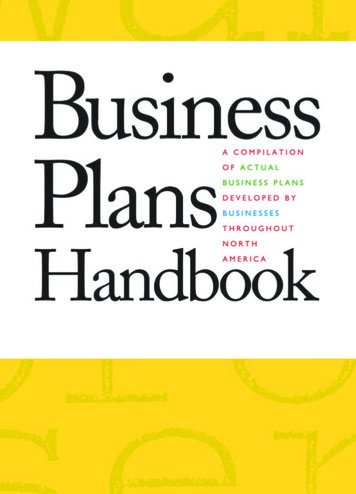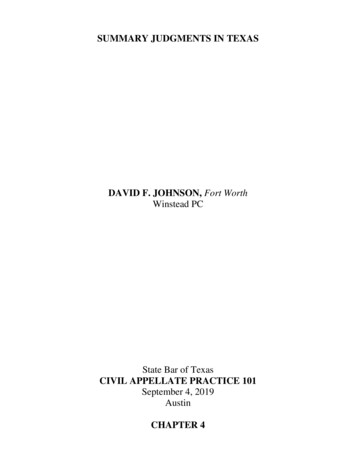
Transcription
SUMMARY JUDGMENTS IN TEXASDAVID F. JOHNSON, Fort WorthWinstead PCState Bar of TexasCIVIL APPELLATE PRACTICE 101September 4, 2019AustinCHAPTER 4
DAVID FOWLER tor.com300 Throckmorton, Suite 1700Fort Worth, Texas 76102(817) 420-8223BOARD CERTIFICATIONS:*Board Certified – Civil Appellate Law, Civil Trial Law, and Personal Injury Trial Law – TexasBoard of Legal SpecializationAWARDS AND HONORS:* Named One of Tarrant County’s Top Attorneys by Fort Worth’s 360 West Magazine in 20172019* Named as a Best Lawyer in America in 2013-2019* Named by Fort Worth Texas Magazine as One of Tarrant County’s Best Lawyers in 2004-2019* Named by Texas Monthly as a “Super Lawyer” in 2013-2019* Named by Texas Monthly as a “Texas Rising Star” in 2004, 2006-2012* Named One of Fort Worth Business Press’s “Power Attorney” in 2014* Named One of D Magazine’s “Best Lawyers Under 40 in Dallas” in 2004, 2006, 2007* Named One of D Magazine’s “Best Lawyers in Dallas” for appellate law in 2008-2010* Named One of Fort Worth Business Press’s “Forty Under Forty” in 2003* Named Top Author in 2016 and 2019 in JD Supra’s 2017 Readers’ Choice AwardsCURRENT LEGAL EMPLOYMENT:*Managing Shareholder of Winstead PC’s Fort Worth Office-Civil Appellate and Trial PracticeEDUCATION:Baylor University School Of Law, Waco, Texas, Juris Doctor, Magna Cum Laude, 1997Baylor University, Waco, Texas, B.B.A. in Accounting, 1994ARTICLES AND CLE MATERIALS:David has published over twenty (20) law review articles on topics including experts, summaryjudgments, charge practice, preservation of error, voir dire, and other topics. David’s articleshave been cited as authority by federal courts, the Texas Supreme Court, the Texas courts ofappeals located in Waco, Texarkana, Tyler, Beaumont, and Houston, and cited by McDonald andCarlson in their Texas Civil Practice treatise and William V. Dorsaneo in the Texas LitigationGuide and in the Baylor Law Review, South Texas Law Review, and the Tennessee Law Review.David has presented and/or prepared written materials for over hundred and fifty (150) continuinglegal education courses.
Summary Judgments in TexasChapter 4TABLE OF CONTENTSI.INTRODUCTION . 1II.SUMMARY JUDGMENT GROUNDS . 1A. Traditional Motion For Summary Judgment . 1B. No-Evidence Motion for Summary Judgment . 3C. Pleadings To Support Ground For Summary Judgment . 5D. Newly Plead Claims . 5III.SUMMARY JUDGMENT RESPONSE . 6IV.SUMMARY JUDGMENT REPLY . 7V.MOTION FOR NEW TRIAL/RECONSIDERATION. 7VI.TRIAL COURT’S STANDARD OF REVIEW . 8A. Traditional Summary Judgment . 8B. No-Evidence Motion . 101. Historical Standard . 102. City of Keller’s Reasonable Juror Standard. 11C. Scope of Review For Summary Judgment Motions. 121. Scope of Review For Traditional Motions for Summary Judgment. 122. Scope of Review For No-Evidence Motion for Summary Judgment . 13VII.TIMING ISSUES REGARDING MOTION, RESPONSE, REPLY AND HEARING . 16VIII.DISCOVERY AFTER INTERLOCUTORY SUMMARY JUDGMENT. 19IX.PRESERVATION OF ERROR . 19A. Preserving Error On Grounds Asserted In Denied Summary Judgment Motion . 19B. Preserving Error Regarding Objections to Summary Judgment Evidence . 19C. Preserving Error Regarding Objections To The Non-Disclosure of Experts . 21D. Preserving Error Regarding Adequate Time for Discovery . 22E. Preserve Complaint Regarding Opponent’s Failure to Produce Evidence in Discovery . 23F. Preserve Complaint Regarding Notice of Hearing . 23G. Preserving Right To Correct Defects In Evidence . 23X.FINALITY OF SUMMARY JUDGMENT ORDERS . 24A. Mafrige v. Ross, 866 S.W.2d 590 (Tex. 1993). . 24B. Reversal of Mafrige. 25C. Challenging Interlocutory Summary Judgments . 28XI.STANDARDS OF APPELLATE REVIEW . 28A. Order Of Review . 28B. Traditional Summary Judgment . 28C. No-Evidence Summary Judgment . 28D. Harmless Error Standard . 30E. Standards of Review Over Adequate Time For Discovery, Evidence Objections,And Motions For Continuance . 30XII.APPEAL OF DENIAL OF SUMMARY JUDGMENT MOTION . 31XIII.MANDAMUS OF RULINGS ON SUMMARY JUDGMENT MOTIONS. 32XIV.STANDARD FOR CHALLENGING A DEFAULT SUMMARY JUDGMENT . 36i
Summary Judgments in TexasChapter 4XV.SUMMARY JUDGMENT RECORD . 36XVI.ADVERSE EFFECTS FROM MOTIONS, RESPONSES, OR EVIDENCE MISSING FROM THERECORD . 37A. Historically . 37B. Currently . 37XVII. ADVERSE EFFECTS DUE TO APPELLATE BRIEFING INADEQUACIES . 39A. Duty To Appeal Claims. 39B. Appellate Court May Not Sua Sponte Raise Grounds To Reverse But MustLiberally Construe Briefs . 39C. Specific Judgments Versus General Judgments . 401. General Definitions . 402. A Party Should Look to the Actual Order Granting Summary Judgment . 40D. Specific Judgments. 401. If The Trial Court Grants The Summary Judgment Motion On A Ground That IsNot In The Motion, The Appellant Should Object To The Trial Court Doing So. . 402. Appellate Courts May Affirm On Any Ground In Motion . 41E. General Judgments . 431. Specific Points of Error Versus General Points of Error . 432. Specific Points of Error . 433. General Points of Error. 444. Criticism of General Points of Error . 475. How to Raise and Brief a Proper Point of Error . 47F. Appellee’s Duty To File Brief. 47XVIII. CONCLUSION . 48ii
Summary Judgments in TexasChapter 4SUMMARY JUDGMENTS IN TEXASI.INTRODUCTIONSummary judgment motions are common place in almost any civil suit in Texas. Whether seeking dismissal ofthe entire case or seeking the dismissal of some (but not all) claims or defenses, parties routinely file motions forsummary judgment. Therefore, almost all attorneys will eventually find themselves asking an appellate court to eitheraffirm or reverse a summary judgment. When in that position, an attorney needs to be aware of a multitude of issuesthat can drastically affect the fate of the summary judgment. This article attempts to address some of the commonissues that arise in summary judgment practice.II. SUMMARY JUDGMENT GROUNDSA summary judgment appeal will stand or fall on two main components: 1) the grounds asserted in the motion;and 2) whether the evidence was sufficient to create a fact issue in reference to the grounds. Science Spectrum v.Martinez, 941 S.W.2d 910 (Tex. 1997). Accordingly, whether the grounds were properly asserted and what groundswere asserted are very important factors in appealing a summary judgment. Id.A. Traditional Motion For Summary JudgmentThe movant must expressly state the specific grounds for summary judgment in the motion. Id.; McLendon v.Detoto, No. 14-06-00658-CV, 2007 Tex. App. LEXIS 5173 (Tex. App.—Houston [14th Dist.] July 3, 2007, pet.denied). The purpose of this requirement is to provide the nonmovant with adequate information to oppose themotion and to define the issues for the purpose of summary judgment. FDIC v. Lenk, 361 S.W.3d 602, n.7 (Tex.2012); Westchester Fire Ins. Co. v. Alvarez, 576 S.W.2d 771, 772 (Tex. 1978). The specificity requirement of Rule166a(c) echoes the “fair notice” pleading requirements of Texas Rules of Civil Procedure 45(b) and 47(a). Id. at 773.If the motion contains a concise statement that provides fair notice of the claim involved to the nonmovant, thegrounds for summary judgment are sufficiently specific. Tomlinson v. Estate of Theis, No. 03-07-00123-CV, 2008Tex. App. LEXIS 372 (Tex. App.—Austin January 18, 2008, no pet.); Dear v. City of Irving, 902 S.W.2d 731, 734(Tex. App.—Austin 1995, writ denied). “Summary judgments . . . may only be granted upon grounds expresslyasserted in the summary judgment motion.” G & H Towing Co. v. Magee, 347 S.W.3d 293, 297 (Tex. 2011) (percuriam) (citing Tex. R. Civ. P. 166a(c)).In McConnell v. Southside Independent School District, the Texas Supreme Court dealt with the issue ofwhether a party properly raised summary judgment grounds. 858 S.W.2d 337, 338 (Tex. 1993). The defendant filedthe summary judgment motion, which asserted only that “there were no genuine issues as to any material facts . . . .”Id. at 339 n.1. In a separate document the defendant filed a twelve-page brief in support of the motion. Id. Theplaintiff filed an exception to the form of the defendant’s motion and argued that the motion did not state the groundsfor the summary judgment. Id. at 344-45 (Hecht, J., dissenting). The trial court overruled the plaintiff’s exception andgranted the summary judgment, which the plaintiff appealed. Id. at 339. The court of appeals affirmed the trial court.Id. The Texas Supreme Court, relying on Texas Rule of Civil Procedure 166a(c), reversed the judgments of bothlower courts. Id. at 343-44. Rule 166a(c) states, “the motion for summary judgment shall state the specific groundstherefor.” Tex. R. Civ. P. 166a(c).Taking a literal view of the rule, the Texas Supreme Court held that a “motion for summary judgment must itselfexpressly present the grounds on which it is made.” McConnell, 858 S.W.2d at 341. Further, the court held that a trialcourt may not rely on briefs or summary judgment evidence in determining whether grounds are expressly presented.Id.; see also Science Spectrum, Inc. v. Martinez, 941 S.W.2d 910, 912 (Tex. 1997); RR Publication & Prod. Co. v.Lewisville Indep. Sch. Dist., 917 S.W.2d 472, 473 (Tex. App.—Fort Worth 1996, no writ).A court of appeals cannot review a ground that was not contained in the summary judgment motion to affirmthat order. ExxonMobil Corp. v. Lazy R. Ranch, LP, No. 15-0270, 2017 Tex. LEXIS 210 (Tex. February 24, 2017);Paragon General Contractors, Inc. v. Larco Constr., Inc., 227 S.W.3d 876 fn. 9 (Tex. App.—Dallas 2007, no pet.).A trial court can only grant summary judgment on the grounds addressed in the motion for summary judgment.Blancett v. Lagniappe Ventures, Inc., 177 S.W.3d 584, 592 (Tex. App.—Houston [1st Dist.] 2005, no pet.); PositiveFeed, Inc. v. Guthmann, 4 S.W.3d 879, 881 (Tex. App.—Houston [1st Dist.] 1999, no pet.) (“When, as here, a trialcourt grants more relief by summary judgment than requested, by disposing of issues never presented to it, theinterests of judicial economy demand that we reverse and remand as to those issues, but address the merits of theproperly presented claims.”).The Texas Supreme Court issued an opinion affirming a trial court’s summary judgment where the issue onappeal was whether a ground was raised in the underlying motion. Nall v. Plunkett, 404 S.W.3d 552 (Tex. 2013). InNall, the plaintiff sued the defendants based on an accident that occurred after a third party left a party being hosted1
Summary Judgments in TexasChapter 4by the defendant. Id. The plaintiff raised a negligence claim based on the defendants’ alleged failure to exercise duecare in their undertaking. Id. The summary judgment motion stated the issue as: “Whether the defendants have anyduty to plaintiff in the factual scenario pled by the plaintiff.” Id. The defendants “short answer” was that “Texas doesnot recognize social host liability, and defendants do not have any duty to the plaintiff in this case.” Id. The court ofappeals held that the trial court erred by granting summary judgment because the defendants failed to address theplaintiff’s negligent-undertaking theory in their motion. Id. The Texas Supreme Court disagreed, holding thatsummary judgment motion specifically addressed the negligent-undertaking claim by arguing that a prior opinionforeclosed the assumption of any duty (i.e., an undertaking) by a social host. Therefore, the Court held that the courtof appeals erred by reversing the trial court’s judgment. Id. The Court reviewed the briefing and arguments in themotion to give flesh to the rather broad issue statement.The party who wants to complain of the form of the motion must “properly” except to it. But what is a “properexception”? Must the non-movant except to the trial court, or can he raise the defect for the first time in his appellatebrief? The Texas Supreme Court set forth some guidelines for deciding this issue. McConnell, 858 S.W.2d at 342-43.When the motion does not present any grounds in support of summary judgment, the non-movant is not required toexcept to it in the trial court. Id. at 342; see also Mercantile Ventures, Inc. v. Dunkin’ Donuts, Inc., 902 S.W.2d 49,50 (Tex. App.—El Paso 1995, no writ). The reasoning is that the motion must stand or fall on its own merits, and thenon-movant’s failure to respond or except to the motion in the trial court should not result in a judgment by default.McConnell, 858 S.W.2d at 342.Where the summary judgment motion presents some grounds, but not all, once again the non-movant is notrequired to except to the trial court because to do so in this situation would require the non-movant to alert themovant to the additional grounds that he left out of his summary judgment motion. Id. See also DeWoody v. Rippley,951 S.W.2d 935, 944 n.7 (Tex. App.—Fort Worth 1997, writ dism’d by agr.). The Court noted that “[a]n exception isrequired should a non-movant wish to complain on appeal that the grounds relied on by the movant were unclear orambiguous.” McConnell, 858 S.W.2d at 342; see also D.R. Horton-Tex., Ltd. v. Markel Int’l Ins. Co., 300 S.W.3d740, 743 (Tex. 2009) (“A non-movant must present its objections to a summary judgment motion expressly bywritten answer or other written response to the motion in the trial court or that objection is waived.”). “However,even when a non-movant fails to except, the court of appeals cannot ‘read between the lines’ or infer from thepleadings any grounds for granting the summary judgment other than those grounds expressly set forth before thetrial court.” Nall, 404 S.W.3d 552 (quoting McConnell, 858 S.W.2d at 343).It is only when the grounds in the summary judgment motion are unclear or ambiguous that the non-movantmust file an exception to the motion with the trial court, thus ensuring that the parties and the trial court are focusedon the same grounds. McConnell, 858 S.W.2d at 342-43. See also Porterfield v. Galen Hosp. Corp., 948 S.W.2d916, 920 (Tex. App.—San Antonio 1997, writ denied); cf. Toubaniaris v. American Bureau of Shipping, 916 S.W.2d21, 24 (Tex. App.—Houston [1st Dist.] 1995, no writ). The Toubaniaris court stated the following:We hold the language in McConnell inapplicable to this case because McConnell only addressed the issuewhether a non-movant should specially except to a motion for summary judgment when the grounds in themotion are unclear or ambiguous. This case involves a motion that is itself ambiguous whether it is amotion for summary judgment or a motion for forum non conveniens.Id. at 24 (footnote omitted). Thus, the non-movant did not have to specially except to the trial court to preserve error.If the non-movant fails to file an exception to a motion with this defect, the only harm the non-movant will incur isthat, on appeal, he will lose the right to have the grounds narrowly focused. McConnell, 858 S.W.2d at 343. Thus, theappellate court can affirm on any ground that was included in the ambiguous summary judgment motion. Id. at 34243. Further, these rules apply to the non-movant’s response and supporting brief because he must also expresslypresent to the trial court any issues that defeat the movant’s “entitlement.” Id. at 343; see also Cornerstones Mun.Util. Dist. v. Monsanto Co., 889 S.W.2d 570, 574 (Tex. App.—Houston [14th Dist.] 1994, writ denied) (“Any issuethat a non-movant contends avoids the movant’s entitlement to summary judgment must be expressly presented bywritten answer to the motion, and not in a brief.”).There is one difference in the consequences that attach to a movant’s failure to file his motion and supportingbrief in the same document and those resulting from a non-movant’s failure to file his response and supporting briefin the same document. McConnell, 858 S.W.2d at 343. A non-movant’s failure to answer or respond cannot, by itself,entitle the movant to a summary judgment because, even if the non-movant fails to respond, the movant still has theobligation to carry his initial burden. Id. at 343. However, this choice is not the most advantageous position for thenon-movant because, on appeal, he may only argue the legal sufficiency of the summary judgment motion. Id. Evenif the party who is required to file an exception to the motion or response with the trial court does so, that party is stillrequired to present the issue to the appellate court in his appellate brief, or he waives the issue. Wilson v. General2
Summary Judgments in TexasChapter 4Motors Acceptance Corp., 897 S.W.2d 818, 823 (Tex. App.—Houston [1st Dist.] 1994, no writ). That the motion orresponse contains the grounds is not the only requirement. The party need not completely brief each ground or issue;he must only notify the opposing party of what they are. Golden Harvest Co., Inc. v. City of Dallas, 942 S.W.2d 682,691 (Tex. App.—Tyler 1997, writ denied) (“The motion for summary judgment must state specific grounds on whichit is made. The grounds in the motion are sufficiently specific if the motion gives ‘fair notice’ to the non-movant.”);see also Harwell v. State Farm Mut. Auto. Ins. Co., 896 S.W.2d 170, 175 (Tex. 1995). Furthermore, if the motionitself states legally sufficient grounds, the trial court does not err in considering a separately filed brief in deciding asummary judgment motion. Golden Harvest Co., 942 S.W.2d at 692.B.No-Evidence Motion for Summary JudgmentJust as a traditional summary judgment movant must present its grounds in the motion, a no evidence movantmust similarly raise any no-evidence grounds clearly in the motion. The no evidence motion should be specific as tothe challenged elements to give fair notice to the non-movant as to the evidence it must present. Timpte Indus. Inc. v.Gish, 286 S.W.3d 306, 310 (Tex. 2009). A party can contest every element of its opponent’s case so long as eachelement is distinctly and explicitly challenged. Martin v. McDonald, 247 S.W.3d 224, 233 (Tex. App.—El Paso2006, no pet.).A party can assert both traditional and no-evidence grounds in the same motion. Merriman v. XTO Energy, Inc.,407 S.W.3d 244 (Tex. 2013); Binur v. Jacobo, 135 S.W.3d 646, 650 (Tex. 2004). And a no-evidence summaryjudgment motion that attaches evidence should not be disregarded or treated as a traditional summary judgmentmotion. Rankin v. Union Pac. R. Co., 319 S.W.3d 58, 63 (Tex. App.—San Antonio 2010, no pet.) (citing Binur v.Jacobo, 135 S.W.3d 646, 651 (Tex. 2004)).If an appellate court determines that the motion did not adequately present the no-evidence ground to the trialcourt, the movant could waive that ground because of the lack of notice to the non-movant. Bean v. Reynolds RealtyGroup, Inc., 192 S.W.3d 856, 859 (Tex. App.—Texarkana 2006, no pet.) (holding that motion that stated only that“there is no evidence to support the plaintiff’s causes of actions and allegations” was ineffective); Thomas v. ClaytonWilliams Energy, Inc., 2 S.W.3d 734 (Tex. App.—Houston [14th Dist.] 1999, no pet.). The Corpus Christi Court ofAppeals has been especially quick to find waiver of no-evidence grounds. Richard v. Reynolds Metal Co., 108S.W.3d 908 (Tex. App.—Corpus Christi 2003, no pet.) (where a summary judgment motion does not unambiguouslystate that it is filed under Rule 166a(i) and does not strictly comply with the requirements of that Rule, then court willconstrue it as a traditional motion); Michael v. Dyke, 41 S.W.3d 746, 750 (Tex. App.—Corpus Christi 2001, no pet.).Further, issues not expressly presented to the trial court may not be considered at the appellate level, either asgrounds for reversal or as other grounds in support of a summary judgment. See generally Tex. R. Civ. P. 166a(c);Stiles v. Resolution Trust Corp., 867 S.W.2d 24, 26 (Tex. 1993); W.R. Grace Co. v. Scotch Corp., 753 S.W.2d 743(Tex. App.—Austin 1988, writ denied); Dickey v. Jansen, 731 S.W.2d 581, 583 (Tex. App.—Houston [1st Dist.]1987, writ ref’d n.r.e.).If the no-evidence point is hidden, the appellate court may simply waive that ground and reverse the summaryjudgment unless one of the movant’s traditional grounds can support the summary judgment. Shaw v. Maddox MetalWorks, 73 S.W.3d 472 n.2 (Tex. App.—Dallas 2002, no pet.); Hunt v. Killeen Imports, No. 03-99-00093-CV, 1999Tex. App. LEXIS 9278 (Tex. App.—Austin December 16, 1999, pet. denied) (not design. for pub.); Thomas v.Clayton Williams Energy, Inc., 2 S.W.3d 734 (Tex. App.—Houston [14th Dist.] 1999, no pet.). For example, in Tellov. Bank One, N.A., the court of appeals found that that the movant waived its no-evidence grounds:The Bank did not specify whether the part of its motion opposing Tello’s counterclaims was a traditionalmotion or a “no-evidence” motion. At times, the Bank used language applicable to a traditional motion;but at other times, the Bank generally asserted that Tello has “no evidence” to support his various claims orfactual allegations. However, the motion did not “state the elements as to which there is no evidence” asrequired by Rule 166a(i). Because the motion did not unambiguously state it was filed under Rule 166a(i)and did not strictly comply with that rule, we construe it as a traditional motion.218 S.W.3d 109 (Tex. App.—Houston [14th Dist.] January 9, 2007, no pet.) (citing Adams v. Reynolds Tile &Flooring, Inc., 120 S.W.3d 417, 420 (Tex. App.—Houston [14th Dist.] 2003, no pet.)).However, some courts are more lenient and will look to the merits of the motion no matter what it is called.Tomlinson v. Estate of Theis, No. 03-07-00123-CV, 2008 Tex. App. LEXIS 372 (Tex. App.—Austin Jan. 18, 2008,no pet.). In Tomlinson, the court found:When a party has mistakenly designated any plea or pleading, the court, if justice so requires, shall treat theplea or pleading as if it had been properly designated. The supreme court has noted that although it is good3
Summary Judgments in TexasChapter 4practice to use headings “to clearly delineate the basis for summary judgment under subsection (a) or (b)from the basis for summary judgment under subsection (i),” the rule does not require it. We will thereforetreat the Albins’ motion as a hybrid motion where, on the issue of testamentary capacity, they met thehigher summary-judgment burden under 166a by conclusively establishing that there existed no genuineissue of material fact.Id. (internal citation omitted).Courts have held that when a party files a dual motion but only argues on appeal “matter of law” points, itwaives its “no-evidence” points on appeal. Brown v. Blum, 9 S.W.3d 840(Tex. App.—Houston [14th Dist.] 1999,review dismissed w.o.j.); but see Young Refining Corp. v. Pennzoil Co., 46 S.W.3d 380 (Tex. App.—Houston [1stDist.] 2001, pet. denied) (more forgiving of drafting of no-evidence grounds). For example, in Salazar v. Collins, thecourt stated:Although Appellees’ motion refers to both subsections (c) and (i) of Rule of Civil Procedure 166a, whichgovern traditional and no-evidence summary-judgment motions respectively, their motion does notdelineate in any manner between traditional and no-evidence claims. Salazar cites the standard of reviewapplicable to traditional summary-judgment motions in his brief, and Collins and Garner do not dispute thatthis is the applicable standard. Therefore, we construe their motion as one for a traditional summaryjudgment.255 S.W.3d 191, fn. 4 (Tex. App.—Waco, 2008, no pet.).If the movant fails to file a specific no-evidence motion, i.e., does not state the elements that he challenges, thenthe non-movant should raise an objection, or more properly a special exception, to the motion. If the non-movantfails to raise this special exception or objection, some courts have held that the non-movant will waive the complainton appeal. Quesada v. American Garment Finishers Corp., No. 08-02-00092-CV, 2003 Tex. App. LEXIS 3338 (Tex.App.—El Paso April 17, 2003, no pet.); Zwank v. Kemper, No. 07-01-0400-CV, 2002 Tex. App. LEXIS 6508 (Tex.App.—Amarillo August 29, 2002, no pet.) (not desig. for pub.); Barnes v. Sulack, No. 03-01-00159-CV, 2002 Tex.App. LEXIS 5727 (Tex. App.—Austin August 8, 2002, pet. denied) (not desig. for pub.); Miller v. Elliott, 94 S.W.3d38 (Tex. App.—Tyler July 24, 2002, pet. denied); Walton v. Phillips Petroleum, Co., 65 S.W.3d 262 (Tex. App.—ElPaso 2000, pet. denied); Williams v. Bank One Texas, N.A., 15 S.W.3d 110, 117 (Tex. App.—Waco 1999, no pet.);Roth v. FFP Operating
*Named by Texas Monthly as a “Super Lawyer” in 2013-2019 *Named by Texas Monthly as a “Texas Rising Star” in 2004, 2006-2012 *Named One of Fort Worth Business Press’s “Power Attorney” in

